
As the movement toward Vision Zero grows – with more than 30 U.S. communities committing to the goal of zero traffic deaths – public transit is increasingly recognized as a core strategy to support safe mobility for all.
View this complete post...







John Hennessy III,
P.E.






As the movement toward Vision Zero grows – with more than 30 U.S. communities committing to the goal of zero traffic deaths – public transit is increasingly recognized as a core strategy to support safe mobility for all.
View this complete post...
Silicon Valley is booming. The economy has come roaring back since the 2008 downturn. In 2013, the total surged past even the 1999 high-water mark of the dot-com boom, and there are more total jobs in the county than ever before. That roaring economy has an impact everyone feels: more traffic.
View this complete post...
Public transit ridership is on the decline in California. But why? Researchers at the UCLA Institute of Transportation Studies (ITS) looked at the data to figure out what’s going on and how the problem could be solved.
View this complete post...
JUNIPER RESEARCH What is a Smart City? “A Smart City is an urban ecosystem that places emphasis on the use of digital technology, shared knowledge and cohesive processes to underpin citizen benefits in vectors such as mobility, public safety, health and productivity.” Many smart city studies have been conducted with the aim of projecting technology […]
View this complete post...
The INRIX 2017 Traffic Scorecard is the largest and most detailed study of congestion to date. It includes data on 1,360 cities in 38 countries covering more than 100,000 square miles (250,000 square kilometers) of road and focuses on congestion across all times of the day and week. It confirms, as previous INRIX Traffic Scorecards have found, that congestion is a significant and growing burden on our cities. It is clear that congestion is a global phenomenon, and impacts businesses as well as commuters, small cities as well as large ones and developing as well as developed economies.
View this complete post...
In the last ten years transit use in Southern California has fallen significantly. This report investigates that falling transit use. We examine patterns of transit service and patronage over time and across the region, and consider an array of explanations for falling transit use: declining transit service levels, eroding transit service quality, rising fares, falling fuel prices, the growth of Lyft and Uber, the migration of frequent transit users to outlying neighborhoods with less transit service, and rising vehicle ownership. While all of these factors probably play some role, we conclude that the most significant factor is increased motor vehicle access, particularly among low-income households that have traditionally supplied the region with its most frequent and reliable transit users.
View this complete post...
The Portland-Metro area has a congestion problem and it’s getting worse. The Oregon Department of Transportation is conducting an analysis to study options, including value pricing also know as congestion pricing, for managing congestion. Learn what this is and how you can participate in the discussion with this video intro.
View this complete post...
2017 was, by many accounts, a turbulent year. Infrastructure was no exception.
Whether due to new political paradigms, unprecedented natural disasters or new funding opportunities, American infrastructure faced a wide range of challenges throughout the year. Here, we recount some of the key infra topics that shaped discussion–and action–in 2017.
View this complete post...
It is widely understood that roadway infrastructure is expensive, both in acquiring land for rights-of-way and in construction of improvements, and thus, decisions regarding alignment, crossing, and access made over a period of decades may have long-lasting consequences that are observable in traffic data today. Consequently, urban areas exhibit different unintentional traffic characteristics, including delays under normal and random stress conditions. Investments motivated exclusively by expected efficiencies under normal operating conditions are unreliable safeguards against loss of efficiency under stress conditions. Therefore, new analytic tools are required that allow designers to assess the adaptive capacity of roadway infrastructure and assess the potential of new investments to provide enhanced resilience.
View this complete post...
The rapid growth of app-based ride services such as Uber and Lyft has raised concerns in large U.S. cities such as New York. San Francisco, Chicago and Seattle about their impacts on traffic congestion and public transportation ridership. In New York City, the growth of app-based ride services (often called “Transportation Network Companies,” or TNCs) has raised questions about how anti-congestion plans being developed by Governor Andrew Cuomo and Mayor Bill de Blasio should address TNCs’ contributions to traffic congestion.
View this complete post...Video, stills and tales. Share images of the Infra in your community that demands attention. Post your ideas about national Infra issues. Go ahead. Show Us Your Infra! Upload and instantly share your message.
Is the administration moving fast enough on Infra issues? Are Americans prepared to pay more taxes for repairs? Should job creation be the guiding determination? Vote now!
What do the experts think? This is where the nation's public policy organizations, trade associations and think tanks weigh in with analysis on Infra issues. Tell them what you think. Ask questions. Share a different view.
The Infra Blog offers cutting edge perspective on a broad spectrum of Infra topics. Frequent updates and provocative posts highlight hot button topics -- essential ingredients of a national Infra dialogue.